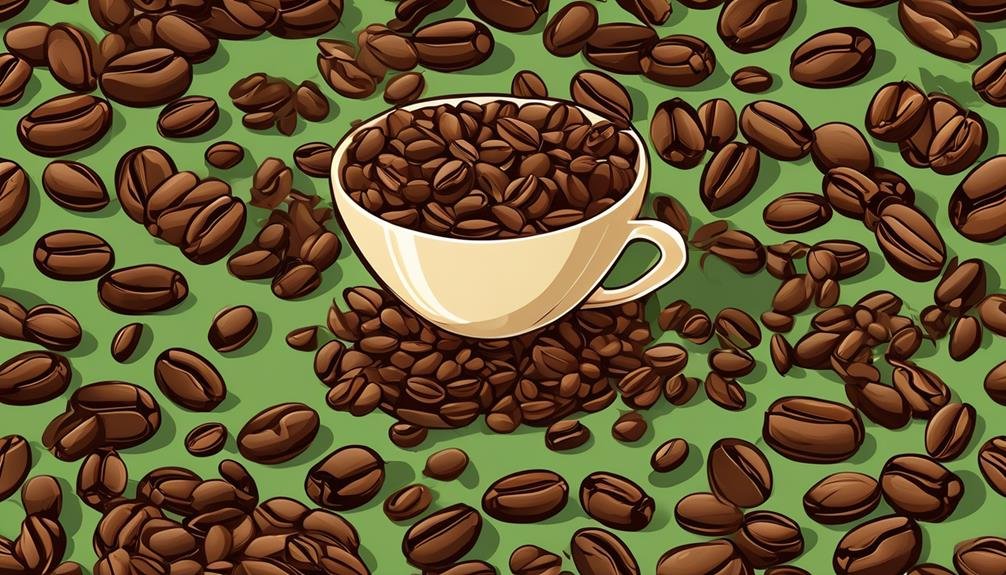Are you curious about what goes on behind the scenes when it comes to roasting coffee beans? Well, buckle up, because you're in for a flavorful ride.
When coffee beans take a trip to the roasting machine, they undergo a remarkable transformation that affects their physical appearance, chemical composition, and ultimately, their taste. But what exactly happens during this process?
How do the beans change from their raw, green state to the rich, aromatic beans we brew in our morning cup? Let's explore the mysteries of coffee roasting and uncover the secrets hidden within those humble beans.
Key Takeaways
- Roasting coffee beans leads to physical changes such as expansion, cracking, and color transformation.
- Chemical reactions during roasting, like the Maillard reaction and caramelization, contribute to the flavor profile of coffee.
- Roasting adjusts the acidity and bitterness levels of coffee, with lighter roasts having brighter acidity and darker roasts having lower acidity and pronounced bitterness.
- The color and aroma of coffee beans are influenced by the Maillard reaction, caramelization, Strecker degradation, and pyrolysis, resulting in a range of flavors and aromas.
Physical Changes During Roasting
During the coffee bean roasting process, various physical changes take place that significantly impact the flavor and aroma of the final product. Understanding these changes is crucial for coffee enthusiasts who desire a deeper appreciation of their favorite beverage.
One of the most noticeable physical changes that occur during roasting is the expansion of the beans. As heat is applied, the beans undergo a process called pyrolysis, where the heat causes the internal moisture to turn into steam. This steam creates pressure within the bean, causing it to expand and crack, resulting in the familiar popping sound known as the 'first crack.'
Additionally, the color of the beans changes during roasting. Initially, the beans are green, but as they're subjected to heat, they gradually turn yellow, then brown, and finally black. This change in color is due to the Maillard reaction, a chemical reaction that occurs between amino acids and reducing sugars in the beans, resulting in the formation of brown pigments.
Furthermore, the roasting process causes the beans to lose weight. This weight loss is primarily due to the evaporation of moisture within the beans. As the beans lose moisture, they become lighter and denser, which can affect the brewing process and ultimately the taste of the coffee.
Chemical Reactions in Coffee Beans
As the physical changes during the roasting process significantly impact the flavor and aroma of coffee beans, understanding the chemical reactions that occur within them is essential for coffee enthusiasts seeking a deeper understanding of their favorite beverage.
During roasting, coffee beans undergo several chemical reactions that contribute to the complex flavors and aromas we associate with a good cup of coffee. Here are some of the key chemical reactions that take place:
| Chemical Reaction | Description |
|---|---|
| Maillard Reaction | The Maillard reaction is responsible for the browning and caramelization of the coffee beans, resulting in the development of rich, complex flavors. |
| Caramelization | As the sugars in the coffee beans heat up, they undergo caramelization, adding sweetness and depth to the flavor profile. |
| Decarboxylation | During roasting, the organic acids in the coffee beans undergo decarboxylation, reducing their acidity and contributing to a smoother taste. |
| Strecker Degradation and Aroma Formation | Amino acids react with sugars through the Strecker degradation, leading to the formation of volatile compounds responsible for coffee's aroma. |
| Pyrolysis and Degradation of Caffeine and Other Compounds | The high temperatures of roasting cause the breakdown of caffeine and other compounds, resulting in the reduction of their concentration in the beans. |
Impact of Roasting on Flavor Profile
The roasting process significantly influences the flavor profile of coffee beans, resulting in a rich and complex taste that coffee enthusiasts crave. During roasting, several changes occur in the chemical composition of the beans, leading to the development of unique flavors and aromas.
Here are three key ways in which roasting impacts the flavor profile of coffee:
- Caramelization: As the beans are roasted, the heat causes the natural sugars present in the beans to caramelize. This process enhances the sweetness and imparts a rich, caramel-like flavor to the coffee.
- Maillard reaction: The Maillard reaction occurs when amino acids and sugars react under high heat, resulting in the browning of the beans. This reaction contributes to the creation of complex flavor compounds, including nutty, toasty, and chocolatey notes.
- Acidity and bitterness: The level of acidity and bitterness in coffee can be adjusted during the roasting process. Lighter roasts tend to have a brighter acidity, while darker roasts have a lower acidity and a more pronounced bitterness.
Color Transformation of Coffee Beans
To understand the impact of roasting on the flavor profile of coffee beans, it's important to explore the remarkable color transformation that occurs during the roasting process. Coffee beans undergo a significant change in color as they're roasted, providing visual cues about their flavor development. The initial green coffee beans have a pale, grassy color. As the roasting progresses, the beans transition through a range of colors, starting from yellow, progressing to light brown, medium brown, and finally reaching a dark brown or even black color.
The color transformation is a result of the Maillard reaction and caramelization. During the early stages of roasting, the beans turn yellow as the heat causes chemical reactions within the beans. As the roasting continues, the beans darken due to the Maillard reaction, which is responsible for the development of rich flavors and aromas. The beans then undergo caramelization, where sugars in the beans are broken down and transformed into complex, sweet flavors.
The intensity of the roasting process determines the final color of the coffee beans. Lighter roasts, such as City or Cinnamon roast, retain more of their original color and have a lighter, more delicate flavor profile. Medium roasts, like Full City or American roast, have a medium brown color and offer a balance between acidity and body. Darker roasts, such as French or Italian roast, have a deep, dark brown or even black color and exhibit bold, smoky flavors with reduced acidity.
Aroma Development During the Roasting Process
During the roasting process, the coffee beans undergo a chemical transformation that leads to the development of complex and enticing aromas. This transformation is a result of various chemical reactions that occur within the beans when they're exposed to heat.
- Maillard Reaction: This reaction is responsible for the creation of many aroma compounds during roasting. It occurs between the amino acids and sugars present in the beans, resulting in the formation of compounds that contribute to the coffee's aroma.
- Strecker Degradation: This reaction involves the breakdown of amino acids, which also contributes to the development of aroma compounds. It occurs in the later stages of roasting and adds to the overall complexity of the coffee's aroma profile.
- Pyrolysis: As the beans are exposed to higher temperatures, pyrolysis occurs, causing the breakdown of complex organic compounds into simpler ones. This process contributes to the development of desirable aromas, such as caramel and chocolate notes.
The length and temperature of the roasting process can greatly influence the aroma development in coffee beans. Lighter roasts tend to have more acidic and fruity aromas, while darker roasts develop deeper, smoky aromas. The combination of these chemical reactions during roasting creates the distinct and captivating aromas that we associate with a good cup of coffee.
Frequently Asked Questions
How Long Does the Roasting Process Typically Take?
During roasting, coffee beans undergo a chemical transformation. The roasting process typically takes around 10-20 minutes, depending on various factors such as desired roast level and bean type.
What Is the Ideal Temperature for Roasting Coffee Beans?
The ideal temperature for roasting coffee beans depends on various factors such as the desired flavor profile, bean variety, and roast level. Generally, temperatures range from 350°F to 450°F to achieve the desired results.
Are There Different Types of Roasting Profiles for Different Types of Coffee Beans?
Different types of coffee beans require different roasting profiles. Factors such as the origin, altitude, and moisture content of the beans play a role in determining the ideal temperature and duration for roasting.
Can the Roast Level Affect the Caffeine Content in the Coffee?
The roast level of coffee beans can indeed affect the caffeine content in your cup. Generally, darker roasts have slightly less caffeine than lighter roasts. However, the difference is minimal and other factors, such as brewing method, also play a role.
How Does the Roasting Process Affect the Acidity of the Coffee?
During roasting, the acidity of coffee beans can be affected. The longer the beans are roasted, the more acidity is lost. This is because the roasting process breaks down the acids in the beans.
Conclusion
During the roasting process, coffee beans undergo various physical changes, such as the expansion and popping of the beans.
Additionally, complex chemical reactions occur, leading to the development of different flavors and aromas.
The color of the beans also transforms from green to varying shades of brown.
Overall, roasting plays a crucial role in unlocking the unique characteristics and taste profiles of coffee beans, resulting in the delightful beverage enjoyed by millions worldwide.




